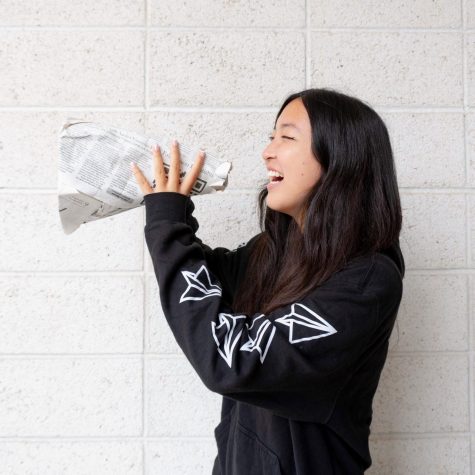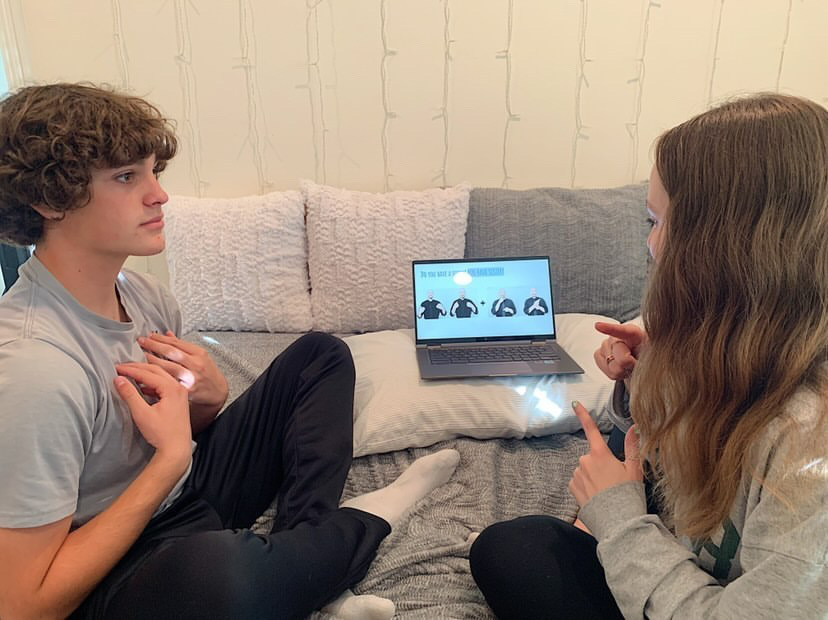American Sign Language Club Motions for Inclusivity
Club member and freshman Alexander Epps often practices signing to co-president and junior Julianna Epps in one-to-one conversations. Together, they work on basics by asking and answering questions in sign language like, “Do you have a sister?”
Delicate fingers move swiftly across the body, each one switching through varying hand motions. Co-presidents and juniors Elyse Dudley and Julianna Epps briskly pull the palm of their hands up to the rim of their mouths and begin pulling their fingers back one by one, mirroring the expression of “colors.” Outsiders may make the assumption that the pair are simply going through hand motions for enjoyment, but in reality, they are having a full-blown conversation.
After witnessing the lack of classes and resources to learn sign language on campus, Dudley and Epps took it upon themselves to highlight the importance of American Sign Language (ASL) on campus themselves by founding the ASL club in 2019.
Because ASL is a language that relies on hand motions rather than spoken word, it is uncommon for most people to know it. Currently, the club houses 12 consistent members, all sharing a passion not just for sign language, but also values like inclusivity and empathy.
“My favorite part is seeing other people get as excited about learning about sign language as me and sharing that excitement and learning something new,” Epps said. “Then, coming back two weeks later and seeing people actually remember stuff that we’re teaching them, like we’re getting through to them, is really fun.”
Although the hand motions are relatively easy to replicate and memorize, teaching the language itself is no easy feat.
“With sign language, there’re so many minute things that are specific to signing because there are also facial and those are so important because it determines whether you’re stating something or asking a question,” Dudley said.
To ensure that each club meeting goes smoothly, Epps and Dudley plan curriculum beforehand. Utilizing tools like Kahoot, Gimkit and Google, the pair highlight one basic topic of sign language each week, all while making sure that the interactive portion of sign language is still intact, despite the restrictions that the pandemic has imposed.
“There are so many people that can’t hear and are hard of hearing, so just knowing how to use ASL in the real world is really important,” freshman and member Elana Chavez said.
Upon learning the basics of the language, Epps even found herself applying her knowledge in her daily life and became a first-hand witness to the positive effects of knowing the basics of sign language.
“I used to work at a fast food restaurant a while ago, and one time I was working in the drive-thru and a lady pulled through, and she was deaf,” Epps said. “She only had words written on her phone screen. She showed it to me, and I was able to have, not a very good conversation, but a little conversation with her, and I could tell that it really made her day to see somebody who could understand her and say something like ‘Have a nice day’ back to her.”
After students are able to return to fully in-person learning, Epps and Dudley said they hope to build an environment that promotes inclusivity by practicing more one-on-one conversations on campus.
“I hope [members] leave our club at least knowing the basic forms of how to start a conversation with somebody like ‘Yes,’ ‘No,’ ‘What’s your name,’ ‘Nice to meet you,’ just that kind of stuff,” Epps said. “You never know how much it can make someone’s day when they think that nobody can understand them, and then somebody in the room can speak back to them in sign language.”
Club meetings are held every other Monday on Zoom for people that are interested in learning more about the basics of sign language.
Your donation will support the student journalists of Portola High School. Your contribution will allow us to purchase equipment and cover our annual website hosting costs.

Claudia Lin is your co-editor-in-chief for her third year on the Pilot. She is looking forward to making as many memories as possible for her last year...




